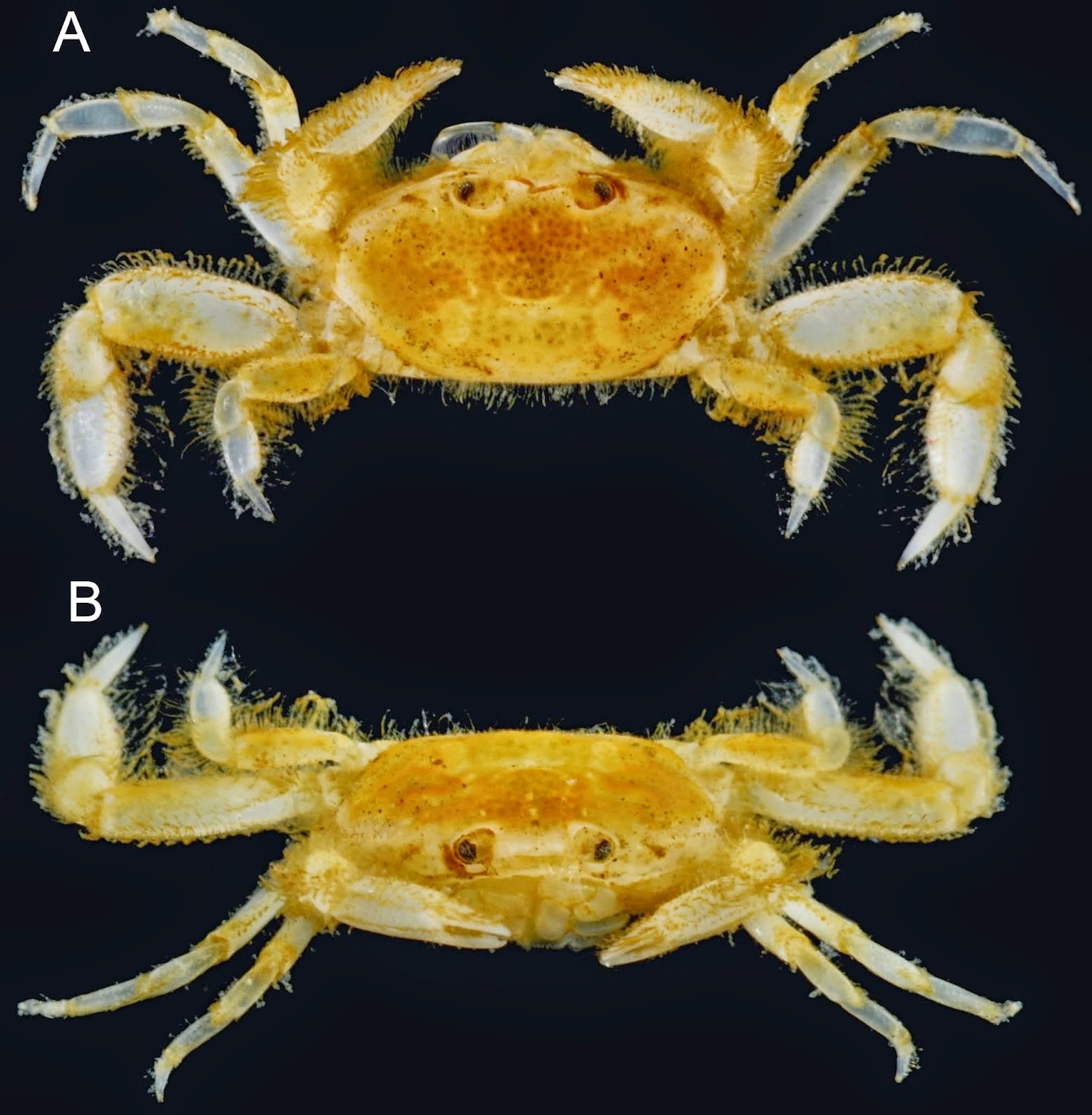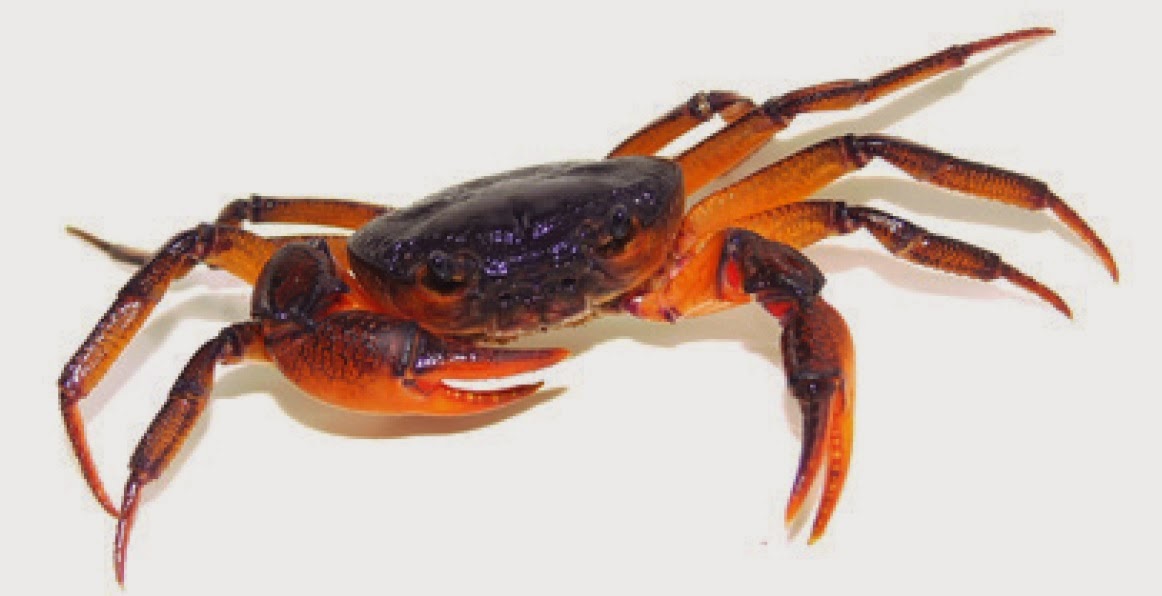Palaeocorystid Crabs are widespread in sedimentary rocks from the
Middle-to-Late Cretaceous across the world. They are interpreted as having been
specialist back-burrowers, a lifestyle that requires several modifications to
the bodyplan of normally sideways-moving Crabs, particularly narrowing of the
body (which is wider than it is long in most Crabs) and reduction of the
surface area of the posterior part of the body.
In a paper published in the journal Zootaxa on 20 August 2013, Barry
Van Bakel of the Oertijdmuseum De Groene Poort and the Naturalis Biodiversity Center describes a new species of Palaeocorystid Crab from the Late Cretaceous Carrière
du Mas Quarry, 3 km northeast of Roullet-Saint-Estèphe in Poitou-Charentes in
southwest France. The beds that produced the Crabs are silty-to-sandy blue-grey
mudstones that have previously produced numerous Oysters, Lingulid Brachiopods,
Shark’s teeth, Fish remains and Decapod Crustaceans in phosphatic nodules.
The new species is placed in the genus Joeranina, and given the specific name houssineaui, in honour of Romain Houssineau, who collected the
specimens from which the species is described. The species is described from
four specimens, with the best preserved being 14 mm in length and 9 mm in
width. The Crabs are known from their bodies only, with no limbs preserved, and
are subhexagonal in shape.
Joeranina houssineaui, upper Cenomanian, ‘Carrière du Mas’, Roullet-Saint-Estèphe,
Poitou-Charentes, southwest France. (A) First specimen, dorsal view of carapace.
(B) Second specimen, dorsal view of carapace. (C) Third specimen, dorsal view of
carapace. (D, E)F ourth specimen, left lateral and dorsal views of carapace. All
specimens whitened with ammonium chloride sublimate prior to photography. Scale
bars 3 mm. Van Bakel (2013).
Unusually for a fossil Crab, which like most marine Arthropod
fossils most often are formed by the shed carapaces of growing animals (the
rigid exoskeletons of Arthropods do not grow with the animals, and instead must
be shed at regular intervals), the first specimen of Joeranina houssineaui shows preservation of much of the internal
structure of the living animal. This enables the internal pleurites (tail
segments of the body, usually hidden in a Crab but exposed in life in some
highly derived Raninoideans) to be seen, with pleurites5 and 6 exposed on the
right hand side and pleurites 4-7 exposed on the left. This enables the
observation of a radial structure in the arrangement of the pleurites, with
pleurite 7 being small and horizontally positioned, and pleurite 8 further
reduced and hidden from view (this radial structure is caused by the tail of
the Crab being permanently coiled up within the shell).
Joeranina houssineaui, upper Cenomanian, ‘Carrière du Mas’, Roullet-Saint-Estèphe,
Poitou-Charentes, southwest France.(A)Left lateral view; (B) ventral view; (C)
anterior/frontal view; (D) posterior view; (E) right lateral view. 1–8,
thoracic sternites 1–8; a1, abdominal somite 1; aP1–aP5b, arthrodial cavity of
P1–P5; ep, epistome; en, endostome; i, intestine; o, orbit; om, oxystomian
mouth; pl4–pl7, pleurite 4–7; pt, pterygostome. Specimen whitened with ammonium
chloride sublimate prior to photography. Scale bar 3 mm. Van Bakel (2013).
See also…
Frog Crabs, Raninoidia, are well represented in the fossil
record across much of the globe in the Late Cretaceous and Cenozoic, but poorly
recorded from the Early Cretaceous, when the group is thought to have
originated. For a long time the majority of early Frog Crabs known were from
Eurasia, leading to...
 A new species of Pea Crab from St. John’s Island, Singapore. Pea Crabs of the genus Indopinnixa are
found living commensally in the burrows of Sipunculan Worms across South and
Southeast Asia. They are morphologically quite variable, with different species
having different carapace structures and numbers of fused segments, but all are
quite small, which gets the...
A new species of Pea Crab from St. John’s Island, Singapore. Pea Crabs of the genus Indopinnixa are
found living commensally in the burrows of Sipunculan Worms across South and
Southeast Asia. They are morphologically quite variable, with different species
having different carapace structures and numbers of fused segments, but all are
quite small, which gets the...
Follow Sceincy Thoughts on Facebook.




